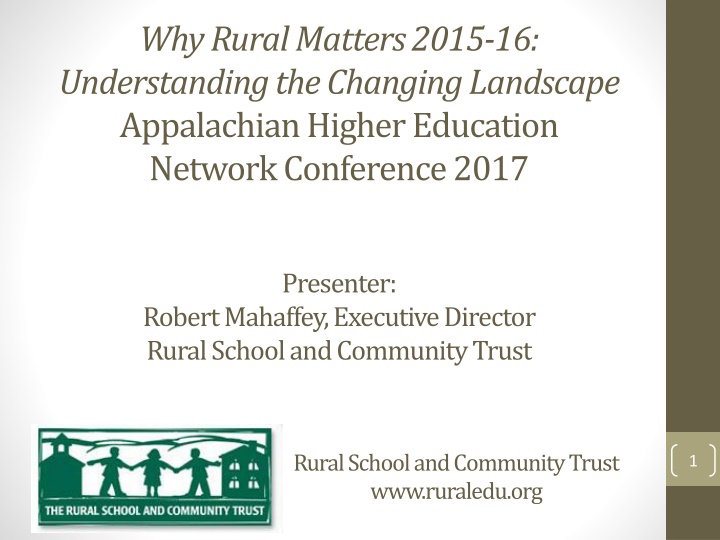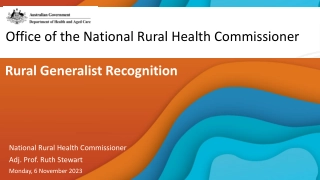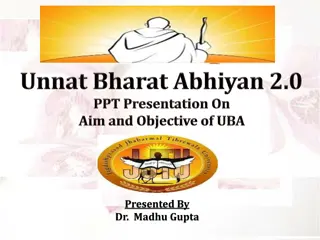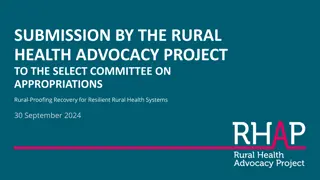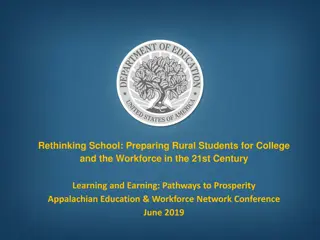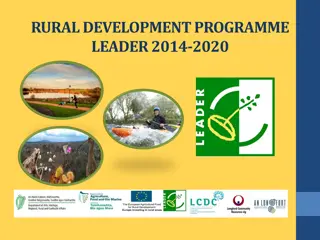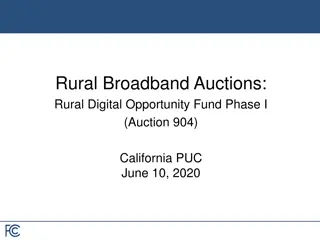Insight into Rural Education Landscape: Why Rural Matters 2015-16
Examining the significance of rural education through reports, indicators, and data sources, while delving into what defines rural areas and cautioning against misinterpreting averages. The presentation at the Appalachian Higher Education Network Conference emphasizes the importance of understanding the changing landscape of rural education.
Uploaded on Sep 22, 2024 | 0 Views
Download Presentation

Please find below an Image/Link to download the presentation.
The content on the website is provided AS IS for your information and personal use only. It may not be sold, licensed, or shared on other websites without obtaining consent from the author.If you encounter any issues during the download, it is possible that the publisher has removed the file from their server.
You are allowed to download the files provided on this website for personal or commercial use, subject to the condition that they are used lawfully. All files are the property of their respective owners.
The content on the website is provided AS IS for your information and personal use only. It may not be sold, licensed, or shared on other websites without obtaining consent from the author.
E N D
Presentation Transcript
Why Rural Matters 2015-16: Understanding the Changing Landscape Appalachian Higher Education Network Conference 2017 Presenter: Robert Mahaffey, Executive Director Rural School and Community Trust Rural School and Community Trust www.ruraledu.org 1
Why Rural Matters Report Every two years, beginning in 2001 Gauges and Indicators Content Narrative State pages Gauge maps Indicator charts 2
What Is Rural? Current Urban-Centric Locale Codes and Handbook Option Set (Handbook Element #0839 Locale Codes): Rural, Fringe: Census-defined rural territory that is less than or equal to 5 miles from an urbanized area, as well as rural territory that is less than or equal to 2.5 miles from an urban cluster. Rural, Distant: 5-25 miles from an urbanized area, or 2.5-10 miles from an urban cluster. Rural, Remote: More than 25 miles from an urbanized area and more than 10 miles from an urban cluster. Urban Cluster = 25,000-50,000 Urban Area = 50,000+
Why Rural Matters 2015-16 Daniel Showalter, Ph.D. Robert Klein, Ph.D. Jerry Johnson, Ed.D. Sara L. Hartman, Ph.D. 4
Data Sources Common Core of Data (NCES) Nation s Report Card NAEP Data (NCES) American Community Survey (U.S. Census) EDFacts (U.S. Department of Education) Office for Civil Rights (U.S. Dept of Ed)
A Caution About Averages: Example Using Poverty Rates in Rural Pennsylvania Rural PA 39.9% Poverty Rate 6
A Caution About Averages: Example Using Poverty Rates in Rural Pennsylvania Rochester Brownsville Purchase Line Panther Valley Albert Gallatin Turkeyfoot Valley 65.1% 64.8% 63.8% 61.7% 61.3% 61.2% Overall poverty rate for rural PA: 39.9% 7
Sample Indicator Results Percent Rural Mobility State Percent Rank Nevada 17.3% 1 Oregon 14.3% 2 Washington 11.7% 16 Mississippi 10.7% 23 New Jersey 5.6% 50 8
Sample Indicator Results Instructional Dollars per Transportation Dollars State Dollars Rank West Virginia $6.54 1 New Jersey $7.16 2 Virginia $8.62 11 Tennessee $13.86 43 Vermont $17.39 48 Alaska $25.81 49 9
Importance Gauge Percent rural schools Percent small rural districts Percent rural students Number of rural students Percentage of state education funds to rural districts 11
Student and Family Diversity Gauge Percent rural minority students Percent rural students eligible for subsidized meal programs Percent rural ELL students Percent rural IEP students Percent rural mobility 13
Educational Policy Context Gauge Rural instructional expenditures per pupil Ratio of instructional to transportation expenditures Median organizational scale (x 100) State revenue to schools per local dollar Rural salary expenditures per instructional FTE 15
Educational Outcomes Gauge Rural Grade 4 NAEP scores (math) Rural Grade 4 NAEP scores (reading) Rural Grade 8 NAEP scores (math) Rural Grade 8 NAEP scores (reading) Rural Grade 8 NAEP scores (science) 17
College Readiness Gauge Overall graduation rate in rural districts Graduation rate for rural minority students Graduation rate for free and reduced meal eligible students Percent rural upperclassmen taking AP courses Percent rural upperclassmen who took ACT/SAT 19
Early Childhood Education Positive Changes: New Head Start performance standards Preschool for All Initiative Food Insecurity School gardens & school-located food banks Reasons for Continue Advocacy: High levels of opioid/heroin addiction High levels of rural child poverty High-stakes testing measures Access to quality, affordable child care Need to increase rural preschool enrollment
STEM Education STEM Ed is a key indicator of: Future of national primacy, Students readiness for post-secondary opportunities, and Socio-cultural markers for individual intelligence. WRM 16-17 STEM report focuses on Teachers Preparation, Professional Development, Recruitment and retention. Students Achievement, Access to STEM Learning and Opportunities Exemplars of Promising Practices
ESSA Rural Implications from ESSA as passed in December 2015 General Programs Involvement provisions Geographic diversity provisions Definitions of need Set-asides Waivers/specialized consideration Rural-specific Programs Changes underway in 2017
English Language Learners Definition 250,000 (3.5% of all rural students) Reclassification Challenges and ideas Parents Teachers School Counselors Administrators First Language Indo- European 23% Other 5% Asian/PI 5% Spanish 67%
Why Rural Matters: Priority Rankings Across Reports 2003 2005 2007 2009 1. Mississippi 2. Alabama 3. Kentucky 4. North Dakota 5. South Dakota 1. Mississippi 2. New Mexico 3. Kentucky 4. Louisiana 5. Alabama 1. Mississippi 2. Alabama 3. Arizona 4. North Carolina 5. Oklahoma 1. Alabama 2. Arizona 3. Mississippi 4. Oklahoma 5. New Mexico 2013-14 1. Mississippi 2. Alabama 3. South Carolina 4. North Carolina 5. Arizona 2015-16 1. Mississippi 2. Arizona 3. Alabama 4. South Carolina 5. South Dakota 2011-12 1. Mississippi 2. Alabama 3. Arizona 4. South Carolina 5. Louisiana 2013-14 1. Mississippi 2. Alabama 3. South Carolina 4. North Carolina 5. Arizona 2015-16 1. Mississippi 2. Arizona 3. Alabama 4. South Carolina 5. South Dakota 26
Questions? 27
Thank you! Daniel Showalter (daniel.showalter@emu.edu) Robert Klein (kleinr@ohio.edu) Jerry Johnson (jerry.Johnson@ucf.edu) Sara L. Hartman (hartmans@ohio.edu) Robert Mahaffey, RSCT Executive Director (robert.mahaffey@ruraledu.org) Alan Richard, RSCT Board Chair (alanricharddc@gmail.com) Rural School and Community Trust (www.ruraledu.org) 28
